Abstract
There is a body of literature on the influence range and traffic risk of fixed work zones. However, relatively few studies have examined the effect of ubiquitous moving operating vehicles, such as road cleaners, on urban roads. The influence of low speed moving work zones on road traffic flow and traffic risk is still unclear. In this work, we used simulations to establish an urban expressway three lanes VISSIM model, and selected the road traffic volume and speed of the moving work zone as the independent variables. We analyzed the range of influence of the moving work zone on the rear vehicles in the left, middle and right lanes of the urban expressway and the traffic risk variation law caused by the moving work zone. The results show that the left lane was indirectly affected by the moving work zone when the traffic volume reached 2000 pcu/h. The influence of the moving work zone on the middle lane was controlled by the traffic volume and the speed of the moving work zone. Both the left and middle lanes were mainly impacted by vehicles changing lane from the right lane. Regardless of the traffic volume and the speed of the moving work zone change, the vehicles 200 m behind a moving work zone will be directly affected in the right lane. Furthermore, the average traffic risk is the highest within 50 m of the moving work zone in the right lane. When the traffic volume decreases and the speed of the moving work zone increases, the average traffic risk decreases gradually. These results provide a scientific basis for the operation and management of moving working vehicles on urban roads.
1. Introduction
With the continued development and expansion of cities worldwide, service requirements for urban traffic are continuously increasing. In order to alleviate urban traffic congestion, the number of intersections and light controls have been reduced to improve speed, and the metropolis has also built a network of urban expressways, which play an indispensable role in connecting entry and exit roads, satellite towns and airports. Due to the needs of daily maintenance and the maintenance of roads, moving work zones (e.g., cleaning sprinklers, road maintenance vehicles) appear regularly on the road. Low-speed moving work zones inevitably affect traffic flow and drivers’ driving behavior on the expressway, thus generating a certain traffic risk. Even though many studies have been conducted to examine the effects of working strategy and work-zone configuration on the resulting travel delay and crash risk at long-term and short-term work zones [1,2,3,4], little effort has been made to assess the traffic impact of moving work zones [5,6]. Theoretically, the traffic impacts of moving work zones could be influenced by the work-zone moving speed, lane position and traffic conditions [7]. However, at present, the influence range of moving work zones on traffic risk is still not clear. Existing studies have focused on the investigation of moving bottlenecks and examined the effects of influencing factors such as traffic density and truck mix rate [8,9]. Despite the overall progress being made in the area of traffic safety, work zone areas remain particularly hazardous zones, as they represent an unexpected change to the usual driving environment [10].
Extensive research has been conducted on section division, traffic flow characteristics, traffic risk and management and control strategies for expressway maintenance work zones, but the research has, to date, focused on the stationary work zone. Therefore, we studied moving work zones on urban roads, and the influence range of moving work zones and variation of traffic risk under different working conditions were analyzed using a simulation in order to provide theoretical support for the management of operating vehicles on urban roads.
The remainder of this paper is organized as follow: Section 2 provides a literature review on the existing studies, Section 3 describes the simulation model used in this paper, in Section 4 we analyze the influence range of moving work zones, traffic risk analysis of the moving work zone is presented in Section 5 and finally, a discussion and the conclusions drawn are presented in Section 6.
2. Literature Review
2.1. Impact Assessment of Work Zones
Various stationary work zone activities, which usually close one or more road lanes, are regularly carried out to maintain a good level of road system service. The lane closure may cause a disturbance to normal traffic flow, resulting in further traffic congestion [11], and the presence of a stationary work zone may increase traffic accident risk [12]. In the assessment of the risk of stationary work zones, Li et al. [13] established a risk assessment model of a highway construction operation area based on a collision severity index. On the basis of analyzing the influencing factors of traffic risk in highway work zones, Meng et al. [14] proposed measuring the risk of rear-end collision in work zones with the rate of collision avoidance reduction. In addition, Mahmoud et al. [15] studied the influence of the location and traffic volume of the road maintenance work area on the workload of drivers through a driving simulator. Wu et al. [16] built a multiple regression model of the single vehicle traffic risk and traffic flow parameters in the fixed operation area of an expressway. Zhou et al. [17] established the VISSIM simulation model of the Shanghai–Nanjing Expressway construction operation area and completed a comprehensive analysis of the factors affecting traffic organization, establishing a prediction model of traffic delay and the number of traffic conflicts. Meng et al. [18] studied the characteristics of traffic conflicts in a semi-closed construction area on a two-way, four-lane expressway and proposed the reasonable length value of the upstream transition section of the construction area based on vehicle queuing characteristics. The result of a driving simulator indicated that the risk of a rear-end collision increased with the reduction in the approach distance from the start of a work zone, suggesting that lane-merging activities should take place further upstream along the road before reaching the work zone [19]. A multilayer feed-forward artificial neural network (ANN) model was developed by Du et al. [20] to estimate the work zone delay and their results indicated that the ANN model outperformed traditional deterministic queuing models in terms of travel delay estimation accuracy. With respect to multi-model simulation, Mahmood et al. [21] proposed separate driver behavior model parameters for heavy vehicles and passenger vehicles of work zone simulation, where the desired time headway was found to be 2.31 s for heavy vehicles and 1.53 s for passenger cars.
2.2. Management Strategy of Work Zones
Xu et al. [22] proposed a driving simulator method to study the relationship between dynamic message sign control strategies and driving safety in a stationary work zone on a freeway. Pesti et al. [23] selected travel time and delay indicators to assess the impact of a stationary work zone on traffic flow, providing an interval estimate for maximum queue length and a method for determining the best closure schedule and start time for planned work zone lane closures. To minimize the influence of work zones on traffic, Waleczek et al. [24] developed a reversible lane system. Based on the nonlinear traffic flow model, Du et al. [25] improved the control strategy of the expressway maintenance work zones. Ge and Wu proposed a method to determine the length of the road maintenance operation area [26,27]. Peng et al. [28] established the VISSIM simulation model of an expressway maintenance operation area, and proposed a method to determine the length of four-lane expressway maintenance work areas. Wu et al. [29] established a layout optimization model for expressway construction areas with traffic accident cost control as the objective; this was based on the estimation of traffic accident impact levels in maintenance and construction areas. Yu et al. [30] proposed a method to determine the location of speed limit signs in expressway construction areas based on the queue length of vehicles and drivers’ short-term memory factors. To study the impact of the various control strategies of freeway work zones on the Level of Service (LOS), Ramadan et al. [31] used the CORSIM micro-simulation platform to evaluate LOS indicators that would help transportation agencies select the appropriate merge control strategy that minimizes the impact on the freeway operations.
Unlike stationary work-zone activities, moving work zones usually have low moving speeds, which could disturb the normal traffic flow and cause traffic congestion and safety problems. However, existing research regarding the operational impacts of moving work zones is very limited: Only two published papers have focused on moving work zones. One studied the traffic impact assessment of moving work zone operations using real vehicle video data processing and simulation methods [32], the other evaluated travel delay and accident risk of moving work zones based on simulation software PARAMICS [7]. The influence range of moving work zones on urban roads and the related change of traffic risk are not yet clear. In addition, some studies focused on the investigation of moving bottlenecks [33,34,35,36], establishing a traffic flow model for a moving bottleneck and evaluating its influence on the upstream and downstream traffic flow by selecting corresponding indexes.
3. Simulation Model
The microscopic traffic simulation approach is useful for evaluating the effects of various influencing factors on traffic impacts caused by the presence of work zones. We used VISSIM software to simulate urban road traffic flow. This simulation model takes a three-lane urban expressway as the prototype, with a lane width of 3.5 m and the speed limit is 80 km/h. According to preliminary work, the influence range of moving work zones on the rear vehicles was not expected to exceed 500 m, so the length of road section was set to 1 km. Data collection points were laid out on the continuous 500 m section, with an interval of 10 m between the collection points, and a total of 150 collection points were set in the three lanes. In an urban road environment, the response time of a driver is generally about 600 ms. Combined with the transmission delay of the vehicle braking system, the total response time of the driver in the model was set as 1 s. Two models, the Wiedemann 74 and the Wiedemann 99, are available in VISSIM, the former suitable for driving behavior simulation of general urban roads in urban areas, while the latter is suitable for expressways. Since the simulation scene set in this paper is an urban expressway with a design speed of 80 km/h, the car-following model selected for the simulation model was Wiedemann 99, and the parameters were set according to the default value of the system.
The variables included in the simulation model were road traffic volume and the speed of the moving work zones. According to the service level grading standard of urban expressways [37], the input road traffic volume parameters were set to 800 pcu/h, 1200 pcu/h, 1600 pcu/h and 2000 pcu/h. In the moving work zones, an urban road cleaner was used as the example. Due to the need for road cleaning, the speed of the cleaner is generally no greater than 15 km/h, so the simulation input variables of the moving work zone speed were set to 5 km/h, 10 km/h and 15 km/h.
4. Analysis of Influence Range of Moving Work Zones
The moving work zone was set to drive in the right lane, and the average speed of vehicles passing through each data collection point under different working conditions was measured. According to the input of different road traffic volume levels, the sampling quantity of each section was within the range of 60–120. The influence of the moving work zone on the traffic flow was analyzed for the left, middle and right lane.
4.1. Left Lane
On a one-way three-lane urban expressway in the city, the left lane is the overtaking lane and the vehicle speed is generally fastest. As shown in Figure 1, when the road traffic volume is 2000 pcu/h, the speed of vehicles behind the left lane changes significantly under the speed conditions of the three mobile operating areas, and the influence range is roughly within 180 m of the longitudinal distance behind the mobile operating area. When the traffic volume is reduced to 1600 pcu/h and 1200 pcu/h, as shown in Figure 2 and Figure 3, the speed of vehicles behind the mobile operation area in the left lane fluctuates within the range of 10 km/h above and below the speed limit of 80 km/h, indicating that the traffic flow in the left lane is not affected. Therefore, under the working conditions shown in Figure 1, traffic flow in the left lane is mainly affected by the lane changes of vehicles in the middle lane and the right lane; that is, the moving work zone has an indirect effect.

Figure 1.
Speed statistics for traffic in the left lane when traffic volume is 2000 pcu/h.
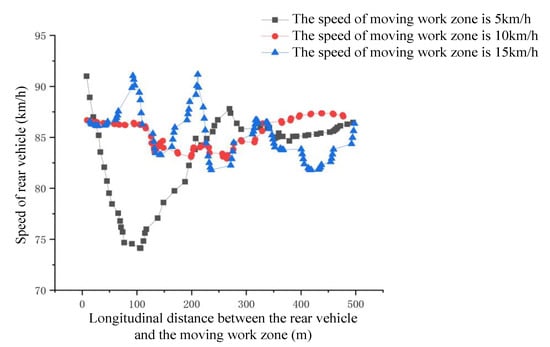
Figure 2.
Speed statistics for the left lane when traffic volume is 1600 pcu/h.
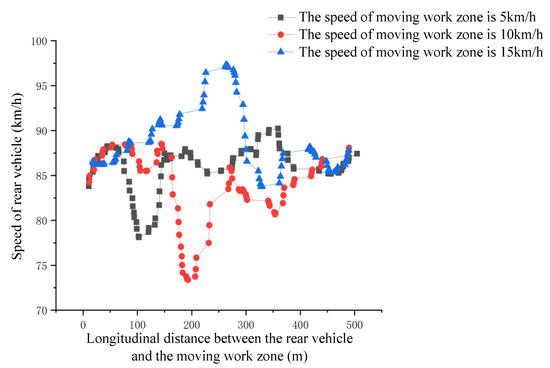
Figure 3.
Speed statistics for the left lane when traffic volume is 1200 pcu/h.
4.2. Middle Lane
As shown in Figure 4 and Figure 5, when the road traffic volume is large, reaching 2000 pcu/h or 1600 pcu/h, the presence of the mobile operation area in the right lane has a significant influence on the traffic flow in the middle lane, and the influence range extends 200 m from back of the mobile operation area. When traffic was reduced to 1200 pcu/h, as shown in Figure 6, and the moving work zone had a moving speed of 10 km/h or 15 km/h, the middle lane vehicle speed fluctuated around 80 km/h and was not significantly affected. However, when the work zone mobile speed decreased to 5 km/h, the rear longitudinal distance of 150 m was within the scope of a larger vehicle speed fluctuation. When the road traffic volume was further reduced to 800 pcu/h, as shown in Figure 7, the moving work zone had no effect on the speed of vehicles in the middle lane, regardless of the moving work zone’s speed. When the traffic volume is large, the middle lane is also affected by lane changes and overtaking in the right lane, that is, the indirect influence of the moving operation area.
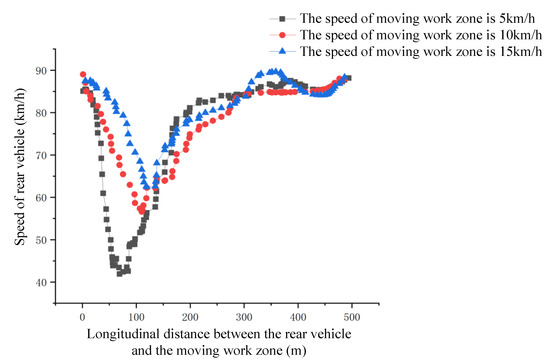
Figure 4.
Speed statistics for the middle lane when traffic volume is 2000 pcu/h.

Figure 5.
Speed statistics for the middle lane when traffic volume is 1600 pcu/h.
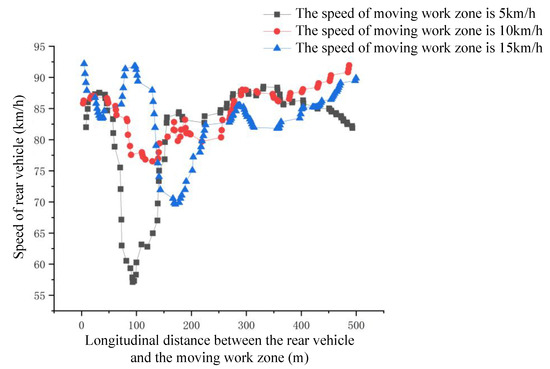
Figure 6.
Speed statistics for the middle lane when traffic volume is 1200 pcu/h.

Figure 7.
Speed statistics for the middle lane when traffic volume is 800 pcu/h.
4.3. Right Lane
As shown in Figure 8, Figure 9, Figure 10 and Figure 11, no matter how the traffic volume changes, the existence of the moving operation area in the right lane always has a significant influence on the rear traffic flow, and the influence range is around 200 m behind the longitudinal distance of the moving operation area. The vehicle speed in the affected area was almost the same, which had nothing to do with the speed of the mobile operation area. When the traffic volume was small, as shown in Figure 10 and Figure 11, the influence range was reduced to 100 m behind the mobile operation area, and the number of samples collected from the data collection point were significantly reduced. The reason for this is that lane change is allowed on urban roads, and at this time, drivers have a relatively wide vision in front of them, so most vehicles choose a lane change and overtake.
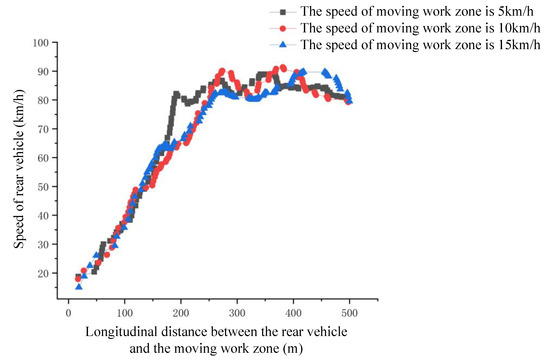
Figure 8.
Speed statistics for the right lane when traffic volume is 2000 pcu/h.
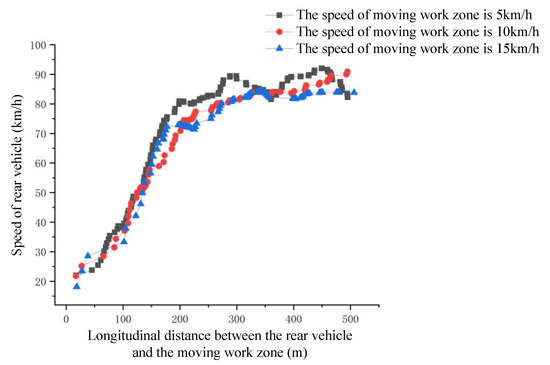
Figure 9.
Speed statistics of the right lane when traffic volume is 1600 pcu/h.
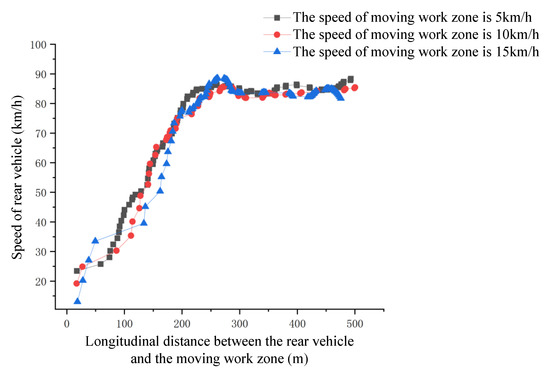
Figure 10.
Speed statistics for the right lane when traffic volume is 1200 pcu/h.

Figure 11.
Speed statistics for the right lane when traffic volume is 800 pcu/h.
5. Traffic Risk Analysis of Moving Work Zone
According to the analysis of the range of influence of the moving work zone, the left and middle lanes are only indirectly affected by the moving work zones when the road traffic volume reaches a certain threshold. This paper does not consider the lane change risk for vehicles caused by moving work zones, and focuses on the right lane, which is directly affected by moving work zones. We focused our research on the influence range of 200 m behind the moving work zone. The speed of vehicles varies greatly in this section, and the traffic accidents are mostly rear-end collisions. Therefore, traffic risk was analyzed theoretically. The general expression of the following model is shown in Equation (1):
where (m/s) and (m/s2) represent the speed and acceleration of the car behind at time (s), respectively; (m) and (m) represent the position of the front and rear vehicle at time t(s), respectively; (m/s) and (m/s) represent the speed of the vehicles before and after, respectively, at time (s); (s) represents the driver’s reaction time; represents the reaction intensity coefficient; and and are constants.
The model calculates the critical acceleration from the relative speed and distance of the front and rear vehicles, and then evaluates the risk of a single vehicle. However, the model ignores the potential risks of vehicles with relatively small relative speeds and high spacing in the actual traffic flow. Guo et al. [38] proposed the method of critical acceleration value to evaluate the risk of single-vehicle following according to the UTSC-1 restricted following model. The index calculation formula is shown in Equation (2):
where is the critical acceleration value; and represent the time speed of the car before and after, respectively; is the safe space for parking, which was set as 1 m in this paper. Other symbols have the same meanings as in Equation (1). The traffic risk index corresponding to the critical acceleration value is shown in Table 1. When the critical acceleration is lower than 2 m/s2, the traffic risk value is 0. With an increase of the critical acceleration, the traffic risk value gradually increases. When the critical acceleration exceeds 8 m/s2, the traffic risk value reaches the maximum value of 10.

Table 1.
Comparison table of critical acceleration and traffic risk index.
The concept of average risk level is introduced to evaluate the overall traffic risk of the road section, as shown in Equation (3):
where represents the average traffic risk level; and represent different risk levels and their occurrence frequency, respectively; and is the traffic volume.
According to Equations (2) and (3) and Table 1, the average traffic risk of the section behind the right lane moving operation area under different working conditions was calculated, and the results are shown in Table 2.

Table 2.
Average traffic risk statistics of road sections.
According to the data in the analysis table, due to the existence of the moving operation area, the sections behind the right lane are all in a state of high traffic risk on the whole, and the average traffic risk within 50 m behind the moving operation area is significantly higher compared with the other three sections. When the road traffic volume reaches 2000 pcu/h and the driving speed in the mobile operation area is 5 km/h, the average risk value of the road section is relatively low. Meanwhile, the average traffic risk of the road section increases with driving speed in the mobile operation area. When the speed of the moving operation area reaches 15 km/h, the average traffic risk value reaches the maximum value of 7.28. That is obviously different from the situation when the traffic volumes are 1600 pcu/h and 1200 pcu/h. This is because when the traffic volume is large, the road is in a relatively saturated state. The right lane is congested due to the low-speed driving of the moving work zone ahead, and the overall traffic flow speed is low, so the rear vehicles are in the “following” state and the average traffic risk is relatively low. With the increase of driving speed of the moving work zone, the rear traffic flow transitions from forced flow to unstable flow, thus the average traffic risk gradually increases.
When the road traffic volume is reduced to 1600 pcu/h, the average traffic risk of the road section significantly reduces, and the traffic risk decreases with the increase of the driving speed in the mobile operation area; however, the overall risk is still high. When the road traffic volume is further reduced to 1200 pcu/h, the traffic risk is also reduced, and more so with increased speed in the mobile operation area. Except for the 50 m range behind the mobile operation area, the traffic risk in the other three sections is lower than 5, and the average traffic risk in the whole section is also below 5, which is acceptable.
Based on the influence range and traffic risk analysis results for the mobile operation area, it is suggested that the working conditions of the mobile operation vehicles on urban expressway should be in conditions when road traffic volume is less than 1200 pcu/h, and the driving speed of the vehicle should not be less than 10 km/h. Vehicles within the influence range of 200 m behind the moving work zone should be effectively warned.
6. Discussion and Conclusions
6.1. Discussion
Using simulations, we studied the range of influence of a moving work zone on the vehicles behind and the change in traffic risk under different working conditions. The results show that the middle lane and left lane are indirectly affected by moving work zones, mainly owing to the lane change of vehicles in the right lane, which is consistent with expectations. The level of influence of the working zone on the left and middle lanes was affected by the road traffic volume and the speed of the moving work zone, the former with a greater effect. The interaction between the two parameters will be the focus of future research. Another finding is that no matter how the traffic volume and speed of the moving work zone varied, the influence range of the moving work zone on vehicles to the rear in the right lane was approximately 200 m. This result may be related to the driver’s forward-looking distance or search path. In addition, the traffic risk calculation results showed that the traffic risk is highest in the right lane within 50 m of the moving work zone. However, with decreased road traffic volume, most vehicles are able to change lanes before entering this danger zone. Considering the decreased road traffic volume in this 50 m range behind the moving work zone, finding effective ways to measure the traffic risk in this area and the risk caused by lane-changing vehicles will be a key focus of future research. In addition, the influence of the number of lanes on moving work zones still needs to be studied.
Using simulation methods can provide technical support for the operation and management of moving work zones on urban expressways. In the next stage of our research, a method using real vehicle tests will be adopted. By contacting the road operation management department, the experimental data will be collected with the vehicle to calibrate the simulation model, and the issues for further study will be our focus.
6.2. Conclusions
Through the simulation analysis of the urban expressway mobile operation area, this paper draws the following conclusions:
(1) The left lane is only indirectly affected by the mobile work zone, which is in the right lane, when the traffic volume reaches 2000 pcu/h, and the influence range from behind the moving work zone extended to around 180 m.
(2) When the traffic volume reaches more than 1600 pcu/h, the middle lane is indirectly affected by the moving work zone running on the right lane and the influence range from behind the moving work zone extended to around 200 m. When the traffic volume reduces to 1200 pcu/h, the middle lane is only affected when the moving work zone is running at 5 km/h and the influence range from behind the moving work zone extended to around 160 m. With further reductions of road traffic volume, the middle lane is not affected by the moving work zone.
(3) The right lane is directly affected by the moving work zone and the impact range is within 200 m behind the moving work zone. The average traffic risk within this area is high, especially within 50 m of the moving work zone.
(4) When the road traffic volume is 2000 pcu/h, the average traffic risk within the influence area of the moving work zone in the right lane increases with the speed of the moving work zone. As the traffic volume is reduced below 1600 pcu/h and the moving work zone speed is increased, the average traffic risk gradually reduces.
Author Contributions
Conceptualization, S.F. and J.M.; methodology, S.F.; software, S.F.; validation, S.F. and J.M.; formal analysis, S.F. and J.M.; investigation, S.F.; resources, S.F.; data curation, S.F.; writing—original draft preparation, S.F.; writing—review and editing, S.F. and J.M.; visualization, S.F.; supervision, S.F.; project administration, J.M.; funding acquisition, J.M. All authors have read and agreed to the published version of the manuscript.
Funding
This research was funded by the Youth Foundation of National Natural Science Foundation of China, Grant No. 51508280 and the Excellent Scientific and Technological Innovation team of Universities in Jiangsu Province, Grant No. 2019042.
Institutional Review Board Statement
Not applicable.
Informed Consent Statement
Not applicable.
Data Availability Statement
Some or all data, models, or code generated or used during the study are available in a repository or online in accordance with funder data retention policies. The data used to support the findings of this study can be offered by the authors upon request.
Conflicts of Interest
The authors declare that they have no conflicts of interest to this work.
References
- Yu, Y.; Weng, J.; Zhu, W. Optimizing strategies for the urban work zone with time window constraints. Sustainability 2019, 11, 4218. [Google Scholar] [CrossRef]
- Chief, S.I.; Goalies, D.G.; Yahalom, Y.S.; Chowdhury, S.M. Simulation-based estimates of delays at freeway work zones. J. Adv. Transp. 2002, 36, 131–156. [Google Scholar]
- Katta, S.J.; Khatam, A.J.; Council, F.M. Effects of work zone presence on injury and non-injury crashes. Accid. Anal. Prev. 2002, 34, 19–29. [Google Scholar]
- Weng, J.; Meng, Q.; David, Z.W. Tree-Based Logistic Regression Approach for Work Zone Casualty Risk Assessment. Risk Anal. 2013, 33, 1–12. [Google Scholar] [CrossRef]
- Liu, G.; Ge, Y.; Qiu, T.; Soleymani, H.R. Optimization of snow plowing cost and time in an urban environment: A case study for the City of Edmonton. NRC Res. Press 2014, 41, 667–675. [Google Scholar] [CrossRef]
- Brown, H.; Sun, C.; Cope, T. Evaluation of Mobile Work Zone Alarm Systems. Transp. Res. Rec. 2015, 2485, 42–50. [Google Scholar] [CrossRef]
- Xia, F.; Weng, J.; Zhang, J. Evaluation of travel delay and accident risk at moving work zones. J. Transp. Saf. Secur. 2019. [Google Scholar] [CrossRef]
- Fang, Y.; Chen, J.; Peng, Z. The effect of moving bottlenecks on a two-lane traffic flow. Chin. Phys. B 2013, 22, 108902. [Google Scholar] [CrossRef]
- Li, Q.; Pan, Y.; Chen, L.; Cheng, C. Influence of the Moving Bottleneck on the Traffic Flow on Expressway. Appl. Mech. Mater. 2011, 97–98, 480–484. [Google Scholar] [CrossRef]
- Osman, A.A.; Turan, A.; Wolfgang, G.; Thomas, E. Development of a precast slim temporary concrete safety barrier STCSB 50 for work zone applications. J. Transp. Saf. Secur. 2019, 11, 287–304. [Google Scholar]
- Fei, L.; Zhu, H.; Han, X. Analysis of traffic congestion induced by the work zone. Phys. A Stat. Mech. Appl. 2016, 450, 497–505. [Google Scholar] [CrossRef]
- Weng, J.; Du, G.; Li, D.; Yu, Y. Time-varying mixed logit model for vehicle merging behavior in work zone merging areas. Accid. Anal. Prev. 2018, 117, 328–339. [Google Scholar] [CrossRef]
- Li, Y.F.; Bai, Y. Development of crash-severity-index models for the measurement of work zone risk levels. Accid. Anal. Prev. 2008, 40, 1724–1731. [Google Scholar] [CrossRef]
- Meng, Q.; Weng, J. Evaluation of rear-end crash risk at work zone using work zone traffic data. Accid. Anal. Prev. 2011, 43, 1291–1300. [Google Scholar] [CrossRef]
- Shakouri, M.; Ikuma, L.H.; Aghazadeh, F.; Punniaraj, K.; Ishak, S. Effects of work zone configurations and traffic density on performance variables and subjective workload. Accid. Anal. Prev. 2014, 71, 166–176. [Google Scholar] [CrossRef]
- Wu, B.; Xu, H.; Dai, T.; Song, C. Simulation evaluation model on driving risk of expressway work zone. J. Transp. Syst. Eng. Inf. Technol. 2013, 13, 151–156. [Google Scholar]
- Zhou, Y.; Wei, J.; Chen, Z.; Wang, Y.; Zhang, M. Traffic organization of expressway maintenance work zone with multi-factors. J. Chang’an Univ. 2020, 40, 99–108. [Google Scholar]
- Meng, X.; Zheng, L.; Hai, F.; Guan, Z.; Xu, H. Research on Traffic Characteristics and Traffic Conflicts of One-way Closed Work Zone on Expressway. China J. Highw. Transp. 2013, 26, 140–146. [Google Scholar]
- Morgan, J.F.; Duley, A.R.; Hancock, P.A. Driver responses to differing urban work zone configurations. Accid. Anal. Prev. 2009, 42, 978–985. [Google Scholar] [CrossRef] [PubMed]
- Du, B.; Chien, S.; Lee, J.; Spasovic, L.; Mouskos, K. Artificial Neural Network Model for Estimating Temporal and Spatial Freeway Work Zone Delay Using Probe-Vehicle Data. Transp. Res. Rec. 2016, 2573, 164–171. [Google Scholar] [CrossRef]
- Mahmood, B.; Kianfar, J. Driver Behavior Models for Heavy Vehicles and Passenger Cars at a Work Zone. Sustainability 2019, 11, 6007. [Google Scholar] [CrossRef]
- Xu, W.; Zhao, X.; Chen, Y.; Bian, Y.; Li, H. Research on the Relationship between Dynamic Message Sign Control Strategies and Driving Safety in Freeway Work Zones. J. Adv. Transp. 2018, 2018, 1–19. [Google Scholar] [CrossRef]
- Pesti, G.; Brydia, R.E. Work Zone Impact Assessment Methods and Applications. Transp. Res. Rec. 2017, 2617, 52–59. [Google Scholar] [CrossRef]
- Waleczek, H.; Geistefeldt, J.; Middendorf, D.C. Traffic Flow at a Freeway Work Zone with Reversible Median Lane. Transp. Res. Procedia 2016, 15, 257–266. [Google Scholar] [CrossRef]
- Du, S.; Razavi, S. Variable Speed Limit for Freeway Work Zone with Capacity Drop Using Discrete-Time Sliding Mode Control. J. Comput. Civ. Eng. 2019, 33, 04019001. [Google Scholar] [CrossRef]
- Ge, H.; Yang, Y. Research on Calculation of Warning Zone Length of Freeway Based on Micro-Simulation Model. IEEE Access 2020, 76532–76540. [Google Scholar] [CrossRef]
- Wu, K.; Zhong, L. A Method for Determining Length of Freeway Work Zone Based on Classification of Service Level. Adv. Mater. Res. 2013, 779–780, 491–497. [Google Scholar] [CrossRef]
- Peng, Y.; Wang, X.; Lu, J.; Wang, W.; Zhang, H. Length determination method for expressway maintenance work zone based on service level. China J. Highw. Transp. 2016, 29, 130–136. [Google Scholar]
- Wu, J.; Zhang, S.; Singh, A.; Ma, Z.; Zhou, B. Optimum layout of freeway construction area based on crash cost control. J. Chang’an Univ. 2017, 37, 97–103. [Google Scholar]
- Yu, R.; Ma, R.; Han, H.; Yan, Y.; Wang, J. Determination method of speed-limit sign position in expressway work zone. J. Traffic Transp. Eng. 2013, 13, 91–98. [Google Scholar]
- Ramadan, O.; Sisiopiku, V. Impact of Bottleneck Merge Control Strategies on Freeway Level of Service. Transp. Res. Procedia 2016, 15, 583–593. [Google Scholar] [CrossRef]
- Edara, P.; Rahmani, R.; Brown, H.; Sun, C. Traffic Impact Assessment of Moving Work Zone Operations (Report DOT F 1700.7 (8–72)); Department of Transportation: Washington, DC, USA, 2017.
- Juran, I.; Prashker, J.N.; Bekhor, S.; Ishai, I. A dynamic traffic assignment model for the assessment of moving bottlenecks. Transp. Res. Part C 2008, 17, 240–258. [Google Scholar] [CrossRef]
- Wu, K.; Guler, S.I. Estimating the impacts of transit signal priority on intersection operations: A moving bottleneck approach. Transp. Res. Part C 2019, 105, 346–358. [Google Scholar] [CrossRef]
- Fadhloun, K.; Rakha, H.; Loulizi, A. Macroscopic analysis of moving bottlenecks. Transp. Lett. 2019, 11, 516–526. [Google Scholar] [CrossRef]
- Ou, H.; Tang, T.-Q. Impacts of moving bottlenecks on traffic flow. Phys. A Stat. Mech. Appl. 2018, 500, 131–138. [Google Scholar] [CrossRef]
- Ministry of Housing and Urban-Rural Development of the People’s Republic of China. Code for Design of Urban Road Engineering (CJJ 37–2012); China Building Industry Press: Beijing, China, 2012.
- Guo, Z.; Dai, Y.; Zhou, X. Critical safety speed and its application research on risk characteristic section of expressway tunnel (tunnel group). China J. Highw. Transp. 2010, 23, 116–122. [Google Scholar]
Publisher’s Note: MDPI stays neutral with regard to jurisdictional claims in published maps and institutional affiliations. |
© 2021 by the authors. Licensee MDPI, Basel, Switzerland. This article is an open access article distributed under the terms and conditions of the Creative Commons Attribution (CC BY) license (https://creativecommons.org/licenses/by/4.0/).